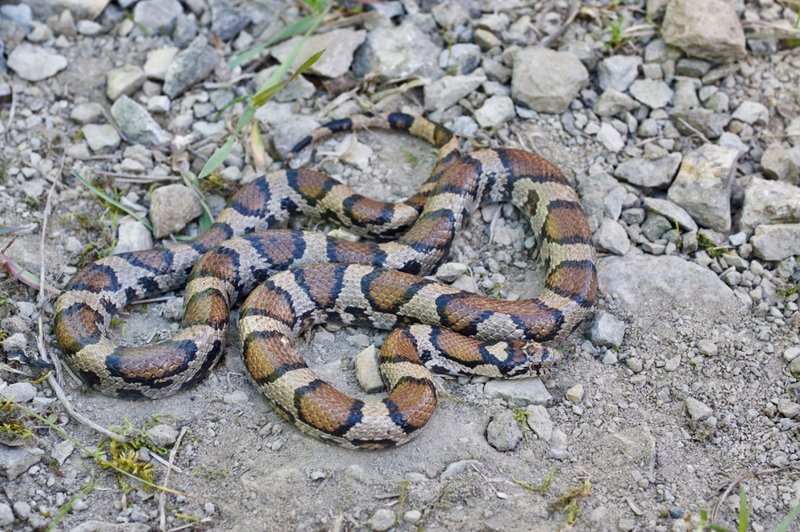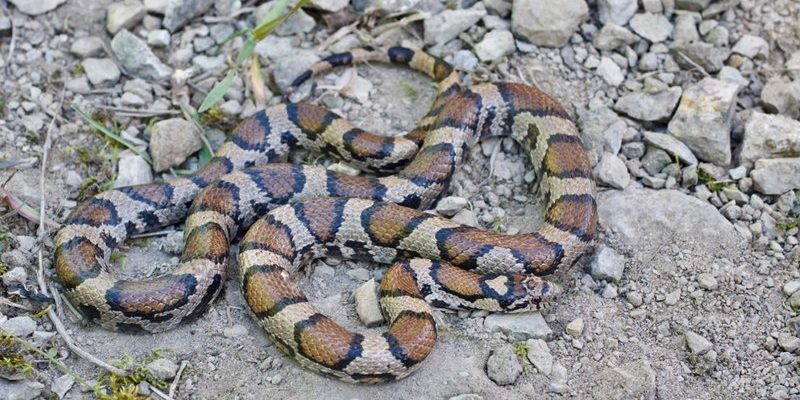
When you think of snakes, you might picture cold, slithery creatures that can send shivers down your spine. But allow me to introduce you to the Milk Snake, a vibrant and intriguing species that often challenges those misconceptions. Known for their striking colors and docile nature, these snakes can be a delight to observe. Imagine a pet that is not only stunning but also relatively easy to care for—sounds appealing, right?
Native to North America, the Milk Snake is part of the Colubridae family, which is one of the largest families of snakes. They are often mistaken for the much more dangerous Coral Snake due to their similar coloration. But fear not! Milk Snakes are non-venomous and pose no real threat to humans. Let’s dive into the fascinating world of these slippery reptiles and learn why they are so special.
Physical Characteristics of Milk Snakes
Milk Snakes are known for their vivid coloration, which often comes in bands of red, black, and yellow or white. This coloration serves two purposes: it’s a beautiful display and a form of mimicry to deter potential predators. These snakes typically grow to an average length of 2 to 4 feet, although some can reach up to 6 feet. Their slender bodies and smooth scales make them agile and quick movers.
One thing that truly stands out is their pattern. The bands usually alternate in color, creating an eye-catching appearance. Interestingly, the specific pattern can vary depending on their location. For example, the Eastern Milk Snake has a more muted color palette compared to its Western counterpart. This variation showcases nature’s capacity for adaptation, which is truly fascinating.
Table of Interesting Facts
| Scientific Name: | Lampropeltis triangulum |
| Average Length: | 2 to 4 feet |
| Habitat: | Grasslands, forests, and rocky areas |
| Diet: | Rodents, birds, and lizards |
| Behavior: | Nocturnal, but can be active during the day |
| Conservation Status: | Least Concern |
| Average Lifespan: | 10 to 15 years |
Habitat and Range
Milk Snakes are primarily found throughout North America, ranging from southern Canada to the eastern United States and into parts of Mexico. They prefer a variety of habitats, including forests, grasslands, and rocky hillsides. This adaptability allows them to thrive in many ecosystems. They tend to be more abundant in areas with plenty of hiding spots like rocks and logs, where they can feel safe from predators.
You might spot a Milk Snake sunning itself on a warm rock or slithering through the underbrush. They are also known to be quite the climbers! That means they can often be found basking in trees or shrubs, adding a whole new layer to their charm. Imagine coming across one basking in the afternoon sun, its colors shining like a jewel—it’s a sight you won’t soon forget!
Diet and Hunting Habits
The diet of a Milk Snake typically consists of small mammals, birds, and even lizards. They are excellent hunters, using their keen eyesight and ability to sense vibrations to locate prey. When hunting, they employ a technique known as constriction. After catching their meal, they wrap their bodies around it tightly to subdue it, making sure it can’t escape.
It’s interesting to note that Milk Snakes are classified as opportunistic feeders, meaning they will eat whatever is available and easy to catch. This adaptability in diet is crucial, especially in regions where food supplies can vary seasonally. Young Milk Snakes usually feast on smaller prey, like insects and small rodents, until they grow large enough to tackle bigger meals.
Behavior and Temperament
Milk Snakes are primarily nocturnal, meaning they are most active at night. However, they can also be seen during the day, particularly in cooler weather when they are basking. They’re generally quite docile and can become accustomed to human interaction, making them popular among reptile enthusiasts. Many people enjoy keeping them as pets due to their manageable size and gentle nature.
If you ever have the chance to handle a Milk Snake, you’ll likely find them to be friendly and curious. They don’t typically bite unless they feel threatened. And even then, their bite is harmless, often just resulting in a quick nip, much like a playful dog. Their calm demeanor and striking appearance make them a great addition to any collection—whether in the wild or in captivity.
Reproduction and Lifespan
Milk Snakes breed in the spring, with females laying eggs in early summer. After a gestation period of about a month, females will typically lay 6 to 24 eggs, depending on their size and health. These eggs are usually found hidden in warm, moist places, which helps protect them from predators and environmental extremes. After about two months, the hatchlings emerge, ready to fend for themselves.
As for their lifespan, Milk Snakes can live up to 15 years in captivity with proper care. In the wild, their lifespan tends to be shorter due to predation and environmental challenges. Keeping them in a suitable environment with proper nutrition can significantly improve their quality of life, allowing them to flourish much like a well-cared-for garden plant.
Common Myths About Milk Snakes
There are several myths surrounding Milk Snakes, primarily due to their coloration and general misconceptions about snakes. One prevalent myth is that all brightly colored snakes are venomous. While it’s true that some colorful snakes are indeed dangerous, Milk Snakes are completely harmless. Their vibrant patterns actually serve as a warning mimicry to deter predators.
Another myth is that Milk Snakes can be aggressive. In reality, they are one of the more docile snake species. If handled gently and respectfully, they are likely to engage, rather than retreat. This behavior might surprise those who have only heard tales about snakes being sly and aggressive. Therefore, it’s important to approach them without preconceived notions, appreciating their unique charm instead!
Conservation Status
Fortunately, Milk Snakes are classified as being of Least Concern on the conservation scale. This means they are currently not facing any significant threats and are relatively stable in their populations. However, habitat loss due to urbanization and agriculture can pose challenges. It’s vital that we continue to protect their natural environments to ensure they remain part of our ecosystems.
Conservation efforts are essential not just for Milk Snakes but for biodiversity as a whole. By educating ourselves about these creatures and their habitats, we can play a part in preserving the natural world. Every step counts, whether it’s creating awareness, protecting habitats, or simply appreciating the beauty of these fascinating reptiles.
FAQ
Are Milk Snakes dangerous to humans?
No, Milk Snakes are not dangerous to humans. They are non-venomous and generally very docile. While they might bite if threatened, their bites are harmless and more akin to a gentle nip than any serious injury.
How can I tell the difference between a Milk Snake and a Coral Snake?
The key difference lies in the color patterns. Milk Snakes have bands of red and black along with white or yellow, while Coral Snakes have red bands touching yellow bands. A helpful rhyme is “red next to black is a friend of Jack, red next to yellow will kill a fellow.” Always be cautious and observe from a distance.
What do Milk Snakes eat in the wild?
In the wild, Milk Snakes primarily eat small rodents, birds, and lizards. They are opportunistic feeders, which means they will consume whatever is readily available. This flexibility in their diet helps them thrive in various environments.
Can Milk Snakes be kept as pets?
Yes! Milk Snakes can make great pets for beginners and experienced reptile enthusiasts alike. They are relatively easy to care for, gentle in nature, and have striking appearances, making them appealing to many snake lovers.
How long do Milk Snakes live?
In captivity, Milk Snakes can live up to 15 years with proper care. In the wild, their lifespan is typically shorter due to factors like predation and environmental hazards.
What type of habitat do Milk Snakes prefer?
Milk Snakes thrive in a range of habitats, including forests, grasslands, and rocky areas. They prefer environments that offer plenty of hiding spots for safety and hunting opportunities.
Do Milk Snakes hibernate?
Yes, Milk Snakes do hibernate during the colder months. Typically, they will find a safe location to brumate (a form of hibernation) when temperatures drop, and will emerge when the weather warms up again.
How can I care for a Milk Snake as a pet?
Caring for a Milk Snake involves providing a suitable enclosure, maintaining the right temperature and humidity levels, and offering a varied diet. Always research proper care techniques to ensure your snake stays healthy and happy.
Are Milk Snakes social creatures?
Milk Snakes are not particularly social. They tend to be solitary in the wild, coming together only for mating. In captivity, they generally prefer their own space, although they can become accustomed to human interaction.
What is the best substrate for a Milk Snake’s enclosure?
A good substrate for a Milk Snake includes aspen shavings or coconut fiber. These materials allow for proper burrowing and help maintain humidity levels, which are essential for their well-being.

